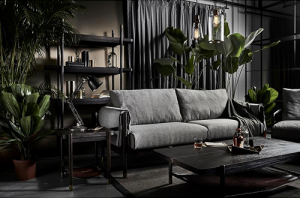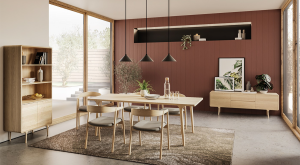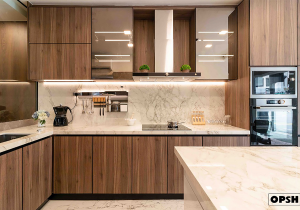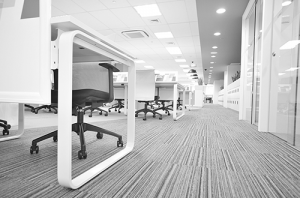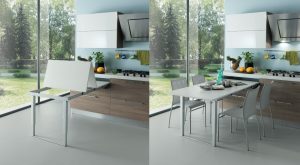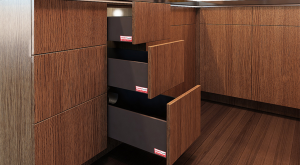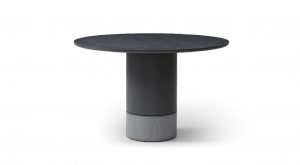For the Love of Craft: Speaking to ipse ipsa ipsum’s Saurabh Mangla
Contemporary luxe furniture brand ipse ipsa ipsum may be young, but it is steadily gaining a following for its handcrafted furniture that feature old-world techniques such as bone inlay and handwoven textiles. Just what keeps founder Saurabh Mangla so convinced about the value of the handmade in this hyper-modern world? And how does this brand tread the balance between preserving tradition and embracing modern aesthetics and business sense? In the middle of his Stay-Home Notice upon returning from a visit to their factories in Dingapur, India, he speaks with us about all this and more.

How did the name ipse ipsa ipsum come about?
As a creative I have a unique issue: I don’t sketch. I write about the product before I design it. I’ve always been more of a word man, so I thought it would be appropriate to delve deeper into the roots of the English language and find something which was unique. Of course, that prompted us to think: what or whom are we doing this for? Why bring about a disruption or change in the industry? It was really about empowerment and having all stakeholders feeling that they have an equal footing on a platform. Hence, we came up with ipse ipsa ipsum, which really means “himself, herself and itself”, or “me, myself and I”. The name reflects a tapestry of individuals, artisans and designers who collaborate across various disciplines to create individualised pieces. It’s a fluid phrase, but the idea really was about celebrating individuality and the power of choice.
That’s quite a departure from Sam and Sara Home, right, which is what the brand was before?
Sam and Sara is a B2B business and we are known in the trade circuit as such, where we serve several global brands via our ODM (Original Design Manufacturing), OEM (Original Equipment Manufacturing) and bespoke design services. But the idea with ipse ipsa ipsum was to do something that was a little bit out of normal and go direct to the consumer, hence the choice of a more individually empowering name.
Having both Sam and Sara and ipse ipsa ipsum means that we are able to utilise our supply chains and production capacity in a manner that can optimise them, and the B2B business is still very important to us.
How has the journey with ipse ipsa ipsum been thus far – any high points or low points?
It’s been an interesting journey. When we started out we weren’t very sure how fast the business would scale. I think what’s happened with COVID is that the situation disrupted the whole industry very abruptly and we had to expand very quickly in response. But given the technological interruptions and interventions, what we’ve created has been good for us.
Our collaborations with local designers have been quite important as well. That’s allowed us to have a different flavour to our normal offerings and also look beyond the furniture industry for inspiration.
So I’d say, between being featured in the film sets of the movie Crazy Rich Asians and having pieces in the Peranakan Museum, I think we’ve had some good periods. I would say that the COVID period has been the low point, because we were all prepared to launch globally, and bang, we get something completely out of the blue and it just slows us down for a while.

What was it like to be involved in designing the set of Crazy Rich Asians?
It was quite interesting the way this whole thing came about. We actually met the people who were designing the set, back when we didn’t have a showroom and were operating out of a small studio at the National Design Centre. We asked them to send us information about the different character personas, and used that as a jumping-off point to propose products for each of the room sets. They came to visit and we put together a little presentation, a simulation, on our projector for them. I think that’s what got them excited – that we had put in an effort for the movie.
Overall I think we had about 40 pieces in the movie: in the jewellery store, which was recreated at the St. Regis hotel, and some of the other bits and bobs in other scenes as well. Every time that we watch the movie, we spot new pieces – we keep finding something hidden somewhere in some nook or cranny.

How would you describe ipse ipsa ipsum’s style?
We always talk about an aspiration of a new design language which is emerging from Asia and rooted in Singapore. Singapore works as an interesting foil for many cultures and subcultures in Asia. We ask ourselves what can be that style which has got a little bit of Chinese, Indian, Malay, Thai… And I think we have a mish-mash of the craft and design aesthetic that resides here. Of course, it’s juxtaposed interestingly with the art deco style from Europe especially in the 1930s and 1940s. It’s kind of a blend, but this is just our template. We always say that we’re just a foil. At the end of the day, it’s really the style of the individual who is customising with us that we’re working with. Ipse ipsa ipsum is there to help you achieve what you want to be and how you want to design your home. People spend so much time trying to find a home for themselves, yet often they end up buying standard furniture which you can find in any store. We say, look, why don’t you hang on and invest in one or two pieces that you can build a connection with.
We had a client who came in who had spent all his time in Tiong Bahru as a child, so we took that as an inspiration point. I showed him some of the tile designs from the Tiong Bahru streets, and we stenciled the design of one of them onto a lamp such that when the lamp was lit, the pattern of the tile would cast a shadow on the wall. The idea is that every time our client looks at the lamp, they’ll have this connection to a happy moment in their childhood playing in the street; something that is very personal and emotional. These are the kind of stories we’re trying to create through furniture, as opposed to just selling solid wood tables, for instance.

It sounds like there’s a very personalised element to the brand, then. How far can clients customise the products to their taste?
We have two services – one is a standard customisation service where you can take existing products in our inventory, such as the Joo Chiat Sideboard and customise the colourways. Then we have the individualisation service. When customers enter our store, they will find a huge material bar done up in brass. It’s got hundreds of materials from different parts of the world. They’re given a tray to put together a palette of materials to their liking, from rock crystal, wood, leather, to the metal finishing. That’s when we start looking at forms and things like that.
For us it’s about staying true to the authentic offer – we’ve got a sincere offer on the market where we’re taking luxury and offering it to the common man on the street. And that’s really our aspiration: that it doesn’t have to be all so secret and shrouded behind iron curtains. You can literally dive deep and get involved in the design process. The artisan who works at the ipse ipsa ipsum craft centre gets an opportunity to continue and earn his living, while you also win by getting something which is unique to you.

Who is ipse ipsa ipsum’s target audience?
The average ipse ipsa ipsum customer is actually a young couple or individual who is looking to buy the one interesting piece to customise for their home. We’re positioned more as an aspirational luxe brand, and we want to offer a sensible price for something that is luxe. To get it customised for you, so there is an emotion, a sense of nostalgia involved in whatever choices you’re making, and it’s a piece you keep for a long time.
I understand your family has its roots in the silverware business. How did you get interested in the furniture business from there?
My grandfather was an officer in the Gurkha army, and he had a lot of exposure to international travel. When he retired, he was looking for something to do. His last posting was in a town where they made a lot of silverware. That’s how we all got involved in this trade.
I was working in the UK when I realised that silver was passé – it needed a lot of maintenance and required polishing every day. But I had this amazing set of skilled craftsmen who were very detail-oriented. I thought that in the next ten years, the consumption of silver is going to come down quite drastically. And I wondered, how do I keep this ecosystem alive? So I thought, let’s apply it to more functional stuff so that their skillsets don’t go to waste, but are applied to things that could be used in an urban environment. I think that’s where the transition happened – purely based on a need to survive, as opposed to any other plan whatsoever.
Does that mean that the people who were working with your grandfather’s set-up are now working with you?
Yeah – we have some people who have been with us for more than forty years. We’ve gone ahead and built this amazing new facility in a kampung in India called Dingapur. We’ve got this very modern-looking infrastructure in the middle of this fairly rural area, where we’ve invited all of the craftsmen to come in so we get to experience a much better platform where they get to practice their skills and perhaps even hone them further.
It sounds like you have to be very attuned to the trends in the marketplace in order to be able to intuit what the industry might want. What are your thoughts when it comes to COVID. Has it changed the way people buy furniture?
I think the furniture industry has reaped the rewards of people staying at home. Everyone’s travel expenses are down because they’re not taking holidays, so they’re upgrading their sofa or changing the coffee table, or adding something else at home. But I think as the situation evolves there will obviously be a big disruption. We’ve seen a lot of businesses being affected, and those who do not pivot in this period are the ones who will get stuck. The idea is to keep looking at the technology evolving and to use that technology to improve your business and to meet new customers as well.
Five years ago, I was so obsessed with the length of a chair that I couldn’t think beyond it. All my concentration was about getting that right and creating new product. Over the past five years, the biggest evolution is learning that as a creative entrepreneur, it’s not just about product; you also need an element of understanding of what’s happening in the world. Looking at other industries and players who are disrupting the market, not necessarily in the furniture industry, and trying to see how you can apply it to your own business. That’s been helpful for me and I think that could be quite good for people.
I went on a trip to New York with the Singapore Furniture Industries Council and Singapore Retailers Association back in January 2018. There I was exposed to many brands like Nike and Apple and because of this trip, that there was so much change between where my headspace was and where the world was actually going. I’d say these brands have been very good in doing what they do in their own industry, and we’re just taking a leaf from their book and trying to think in a different manner about the same service or product. That trip was my Eureka moment, where I realised that things could be done in a different manner. We already had some ideas, but then it was all about how to amplify it.
You often speak of wanting to disrupting the global handmade industry. What does that mean to you?
Again, it goes back to the ethos of our brand – it’s about giving the power of choice to the individuals who will actually consume the product. It will liberate the makers to do what they do and get recognition for their work. It would give designers an opportunity to design with materials and skills which are scarcely available. We’re moving away from that black box factory concept where you can get a whole home out of a black box factory now and it can be shipped over to you. We’ve completely gone the opposite way and it’s like the slow food movement where everything kind of takes its time, but there’s the equal opportunity and sense of respect and homage to the people who are involved in the whole process.
It’s important to me that we always design with warmth, and I think the warmth comes in from actual people behind the product as opposed to just machines. We must create a more interesting cycle for our organisation so that everyone wins along the way. Otherwise technology is probably going to disrupt everything very quickly and leave a lot of people displaced. Let’s think of a way where we can all co-exist and share a bit of the bite with everyone.
Absolutely. Do you think the market is ready for this though?
We’re trying to sell the narrative. We may be a little early, but at the end if you’re really passionate about what you believe in, I do think that the world is your oyster. In Singapore, there’s the emergence of a new maker’s movement where people are taking more of an interest in making and how things are made, at least, and I think that’s going to be quite important as we go along. There’s all this talk about ESG (Environmental, Social, and Corporate Governance), and we’re trying to do it with our own resources at a very micro level. But I’m sure once the big companies throw their weight behind it then there’ll be a general shift in consumption as well.
Do you feel that artisanal crafts are at a risk of turning extinct then?
If we can actually make them relevant, I think they will not be extinct. We have to make an effort. Because if we do not pursue or encourage this, I’m sure people will take the easy way out.
At the same time, in making something by hand, you must also keep the quality of the product high. You must keep it interesting, and it must be functional. For us, that is the big challenge which we are trying to bridge all the time. I don’t think craft would survive if it is being propped up artificially. It has to really be embedded in functional consumption on an everyday basis, and have real value to people. It’s very important to tick all the boxes. I mean, it’s a demanding world out there, and you can’t say that you want to do this but not that. I think it’s about trying to make things convenient, but at the same time having an angle of culture, heritage or nostalgia all rolled into one.
ipse ipsa ipsum works with many different traditional craft techniques. Do you have any favourites?
I have a new favourite all the time. It’s hard to say, but I’ll tell you the new one that we’ve been working on. I arrived in India in the middle of this pandemic, braved all the flights and went over because the plant had to start. When I was there, I found weavers in the neighbouring villages who make hand-spun thread and weave with traditional looms. This was something completely new for me. We’ve been developing a new line of organic cotton upholstery. It’s completely handspun and done on the handloom, but when you sit on the sofa you just float away. It’s done in full feathers and super comfortable.
So I think at the moment I’m obsessed with textiles. How does handspun thread, organic cotton actually make it to people’s homes with comfort? It’s still empowering the weaver, who has been so badly hit that the looms, even five months ago, were empty. They were lying completely closed. Over the last one and a half months we’ve started to get orders and the looms are starting again, and just to stand in the workshops and hear the waft and the weave going is like music to my ears. It has a kind of beat to it [laughs] so I think that’s my favourite technique at the moment.

All images are courtesy of ipse ipsa ipsum.
[By Michelle JN Lim]
28 February 2021


